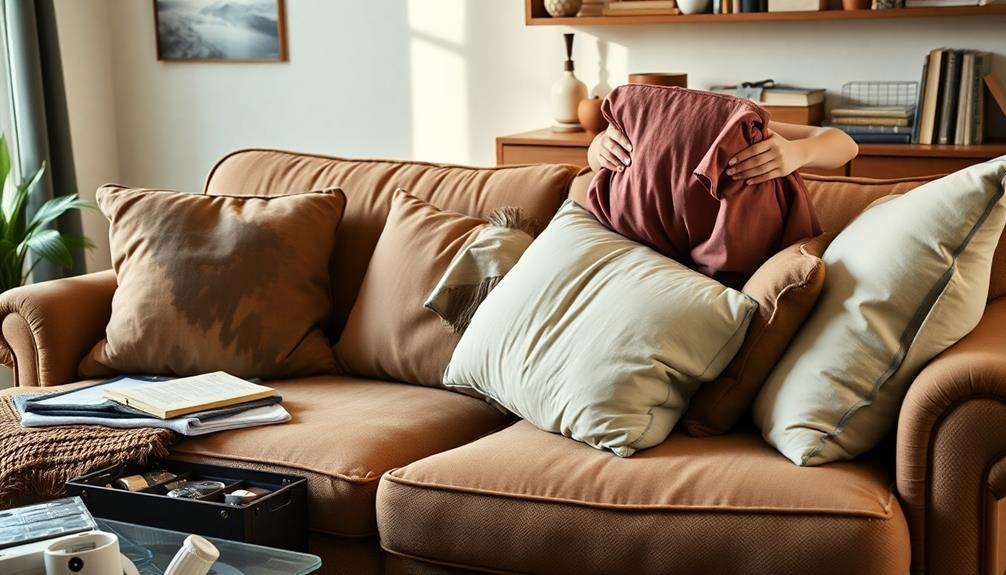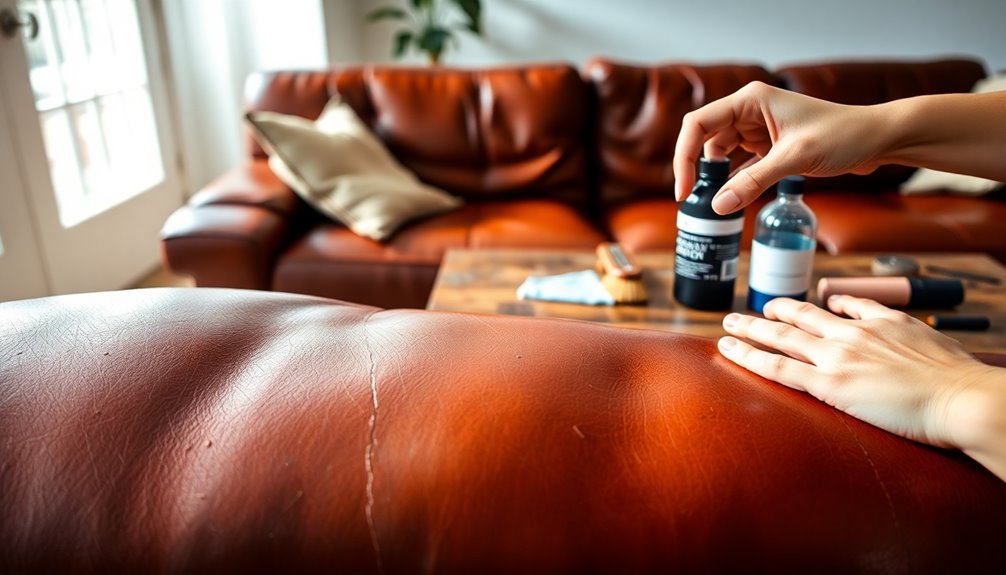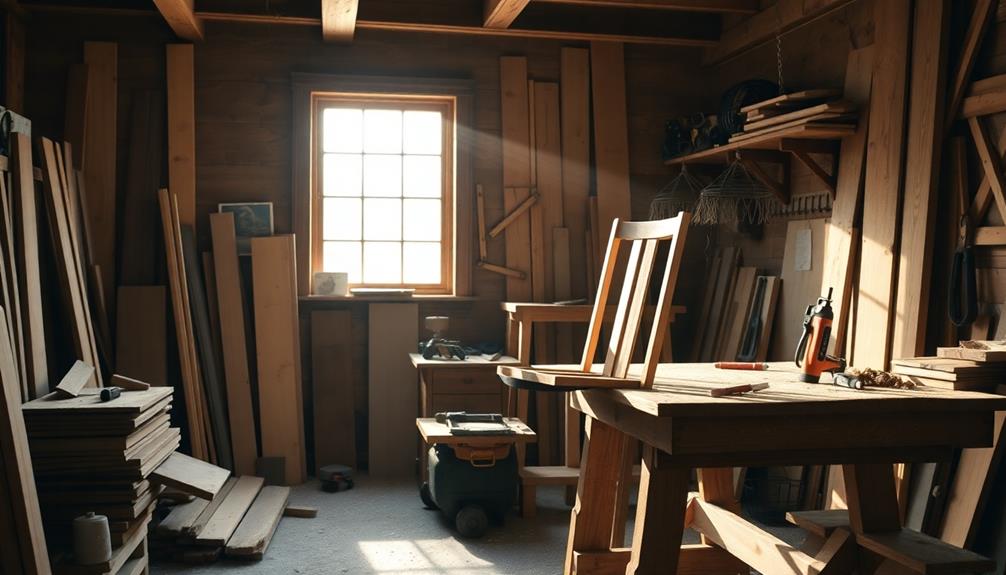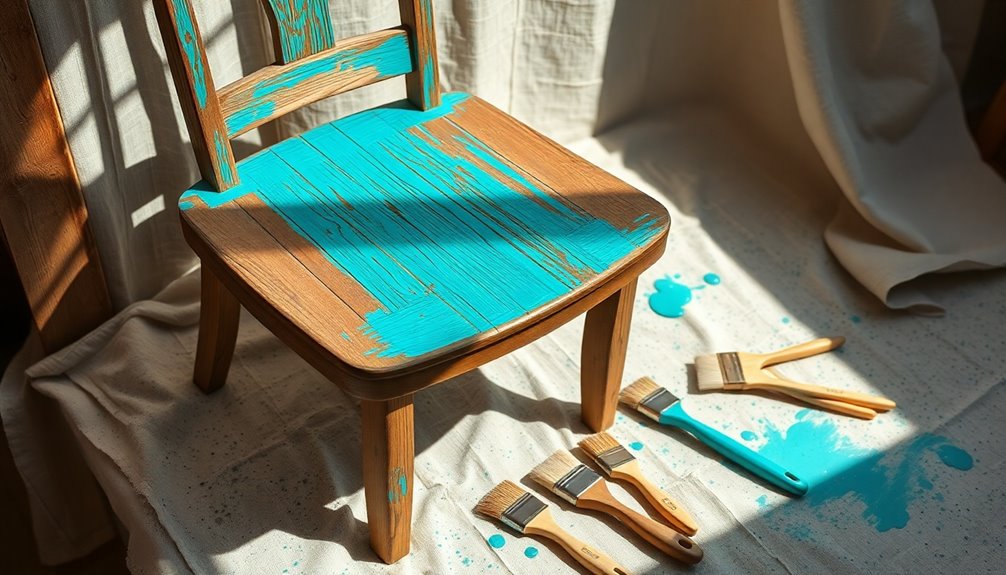To improve the condition of your sofa cushions, start by identifying any issues such as sagging or dirt buildup. You can restore the shape by adding polyester fiberfill or quilt batting. For sagging cushions, consider using high-density foam inserts or sturdy supports to evenly distribute weight. Make sure to regularly fluff and rotate your cushions to maintain comfort and prevent uneven wear. Create a cleaning schedule with weekly vacuuming and spot cleaning to extend the lifespan of your cushions. Remember to occasionally check under the cushions for any hidden debris. You will find more effective solutions and tips on how to refresh your cushions and keep them looking new. Another idea for a more comfortable sofa experience is to invest in machine washable cushion covers to easily address dirt and spills. You can also try mixing and matching cushion styles to enhance both the look and comfort of your sofa. Adding throw pillows can provide extra support while adding a decorative touch. Consider getting a slipcover for added protection and an improved appearance for your sofa. When it comes to making your sofa more comfortable, layering soft throws or blankets can add warmth and coziness without major changes. Lastly, customize your cushion arrangement by using different sizes and densities to suit both comfort and style preferences.
Key Takeaways
- Regularly fluff and rotate cushions to maintain their shape and prevent sagging.
- Add high-density foam inserts or polyester fiberfill to restore comfort and support.
- Use rigid cushion supports beneath cushions to distribute weight evenly and prevent sagging.
- Establish a cleaning routine that includes vacuuming and spot cleaning to maintain appearance and hygiene.
- Inspect and adjust stuffing through zippers on cushion covers for easy maintenance and rejuvenation.
Common Cushion Problems
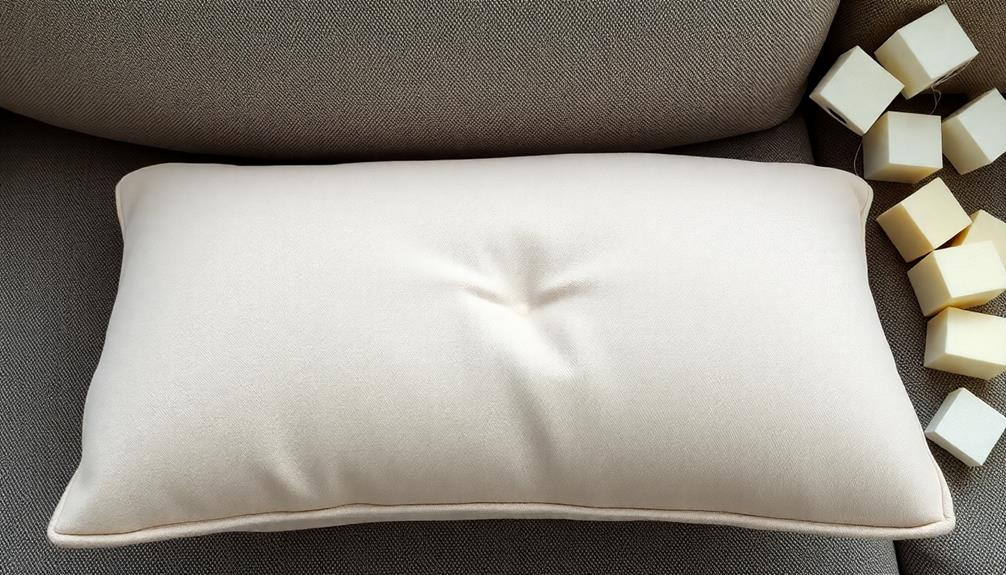
Have you ever noticed how your sofa cushions seem to lose their shape over time? It's a common problem that many face, especially with saggy couch cushions. Over the years, daily wear and tear can wear out the foam insert, leading to discomfort and an uninviting appearance.
If you've got an old couch, chances are the cushions have suffered from poor quality foam. Low-density materials often compress too easily, resulting in cushions that just won't bounce back. Additionally, regular cleaning is essential to maintaining your sofa's appearance and comfort, much like how proper care can prevent issues like ear pressure during colds.
You might also find that loose cushions contribute to the issue, making it hard to find a comfortable seating position. Pets can exacerbate this problem, as their movements can accelerate wear and tear on your cushions.
Additionally, dirt and debris tend to accumulate under the cushions, further compromising their integrity and comfort.
Regular cleaning is essential to maintaining your sofa's appearance and comfort. By addressing these common cushion problems, you can extend the lifespan of your furniture and enjoy a more comfortable seating experience.
Causes of Sagging Cushions

What factors lead to those sagging cushions that make your sofa feel uncomfortable? One major culprit is wear and tear. Daily use puts constant pressure on your seat cushions, causing the foam and stuffing to compress over time. This results in cushions that lose their original shape and support.
If your sofa's cushions are made from poor quality foam, they're even more prone to sagging. Low-quality materials just can't withstand regular use like higher-quality options can. Additionally, the unique charm of your space can be compromised if your furniture isn't in good condition, emphasizing the importance of maintaining comfort and aesthetics in your interior design effective preparation for furniture upkeep.
Another factor is improper weight distribution. If you tend to sit in the same spot repeatedly, you create uneven wear on your cushions, which contributes to sagging. Age plays a role too; as your sofa gets older—typically around five years—the materials lose their resilience, leading to those dreaded saggy cushions.
Effective Repair Techniques

When it comes to fixing your sofa cushions, you've got several effective techniques at your fingertips.
Restoring their shape, adding extra support, and implementing regular fluffing and maintenance can make a big difference.
Additionally, just like with appliance maintenance plans, preventive care for your sofa cushions can prolong their lifespan and enhance comfort.
Let's explore these strategies to bring your cushions back to life.
Restoring Cushion Shape
Restoring the shape of your sofa cushions can greatly enhance both comfort and aesthetics. If you're dealing with sagging couch cushions, there are effective techniques you can use to rejuvenate them. Here are three methods to contemplate:
1. Add Polyester Fiberfill: If your cushions have zippers, open them up and add polyester fiberfill. This will effectively restore the shape and firmness, helping them regain their original loft.
Additionally, contemplate creating a budget for your home improvements to keep track of expenses related to repairs and upgrades, which is essential for overall financial health.
2. Use Quilt Batting: Wrap quilt batting around foam inserts for additional support and comfort. This not only enhances the feel of your couch cushions but also helps them maintain their shape over time.
3. Incorporate Extra Stuffing: Don't hesitate to use old bed pillows or extra stuffing. This cost-effective solution can greatly improve the seating comfort and appearance of your cushions.
Additionally, regularly flipping and rotating your cushions will help distribute wear evenly, preventing uneven compression.
Adding Extra Support
To enhance the comfort and longevity of your sofa cushions, adding extra support is crucial. If you're dealing with saggy sofa cushions, consider inserting high-density foam inserts. These inserts provide durability and resilience, greatly improving comfort over time. They're a straightforward solution that can breathe new life into your couch.
Additionally, confirming that the air quality in your living space is ideal can contribute to maintaining the overall condition of your furniture and cushions air quality considerations.
Another effective method is to utilize cushion supports, like rigid panels placed beneath the cushions. This distributes weight evenly and restores firmness, effectively preventing future sagging.
Layering materials such as quilt batting or fiberfill can also enhance the volume and support of your cushions, allowing for a customized comfort level tailored to your preferences.
For a quick fix, think outside the box—using old crib bumpers as stuffing can offer additional firmness and support without the expense of replacements.
Remember, regularly flipping and rotating your cushions helps maintain their shape and prolongs their lifespan by evenly distributing wear and tear.
Fluffing and Maintenance Techniques
Fluffing your sofa cushions regularly is vital for maintaining their volume and comfort. By redistributing the filling, you prevent compression and keep your cushions looking fresh.
Additionally, verifying that your living space is free from allergens can enhance your overall comfort, just like using the best vacuums for dust removal in 2024 to keep your home clean.
Here are some effective maintenance techniques to verify your cushions stay in top shape:
- Fluff and Rotate: Every few months, take the time to flip and rotate your cushions. This promotes even wear and reduces the risk of sagging, extending the lifespan of your sofa.
- Rejuvenate with Polyester Fiberfill: If your cushions have lost their shape, consider adding polyester fiberfill or quilt batting. This extra stuffing will provide support and help restore the cushions to their original form.
- Regular Cleaning: Spot clean and vacuum your cushions regularly. This removes dirt and debris that can compromise their integrity and keeps them looking pristine.
If your cushions have zippers, accessing and adjusting the stuffing can make maintenance straightforward.
Maintenance Tips for Longevity
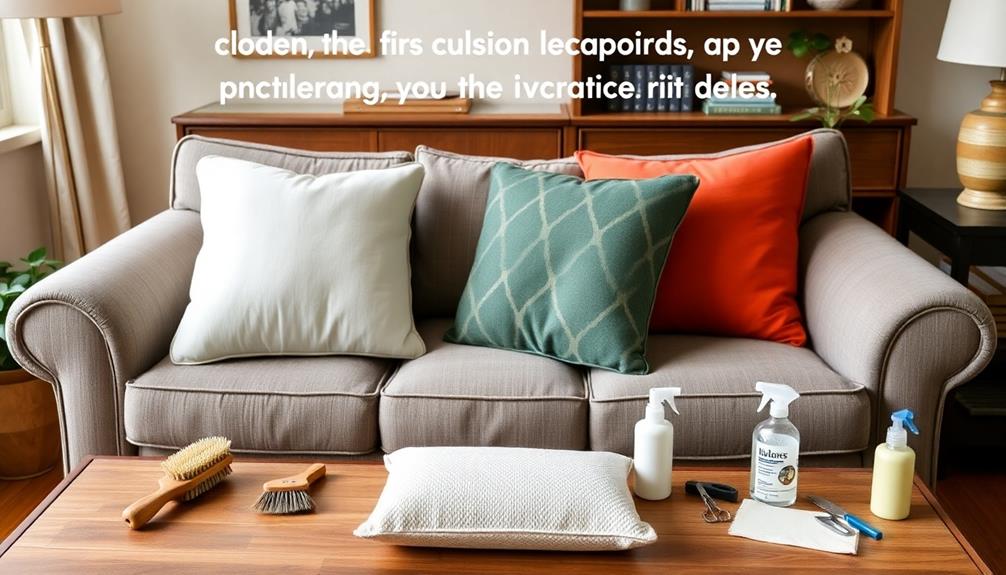
Maintaining your sofa cushions is vital for their longevity and overall comfort. Start by regularly rotating and flipping your couch cushions every few months. This simple practice helps distribute wear evenly, preventing sagging and extending their lifespan.
Fluffing cushions frequently, ideally on a weekly basis, is another key step. This keeps them maintaining volume and comfort by redistributing stuffing and preventing clumping. Additionally, consider using essential oils like eucalyptus oil for a revitalizing scent that can uplift your living space while you maintain your cushions.
Keeping your cushions clean is important, too. Vacuum them weekly to eliminate dirt and debris, and wash removable covers according to care labels. This not only preserves their aesthetic appeal but also prevents dirt buildup that can degrade the fabric over time.
If you want to enhance durability, consider investing in high-quality foam inserts. They greatly improve resistance to sagging, prolonging the life of your cushions.
Don't forget to regularly inspect your cushions for indents or signs of sagging. Early detection allows for timely interventions, such as adding stuffing or using supports, to keep your cushions comfortable and looking great.
DIY Solutions and Resources

Reviving sagging sofa cushions can be a rewarding DIY project that enhances both comfort and aesthetics. You don't need to be an expert to make effective stuffing adjustments.
Regular maintenance is essential for preserving your furniture's condition and appearance, much like preventing cross-contact in food preparation areas. Here are three solutions to keep in mind:
- Polyester Fiberfill: Adding polyester fiberfill can effectively restore the shape and firmness of your couch cushions. You can find a 10lb box at retailers like Walmart for around $19.97.
- Quilt Batting: To enhance comfort, think about using quilt batting. Two rolls typically cost about $7.97 each and can be layered with foam for added support.
- Alternative Stuffing: Get creative with your stuffing! Community insights suggest using old bed pillows or crib bumpers as alternative materials, showcasing various successful DIY methods for cushion rejuvenation.
Don't forget the importance of regular rotation. Flipping and rotating your cushions helps distribute wear evenly, prolonging their life and maintaining their appearance.
Accessing zippers on your cushion covers allows for easy stuffing adjustments, making this a straightforward DIY project without the need for sewing. Enjoy the process and the results of your hard work!
Cushion Support Options
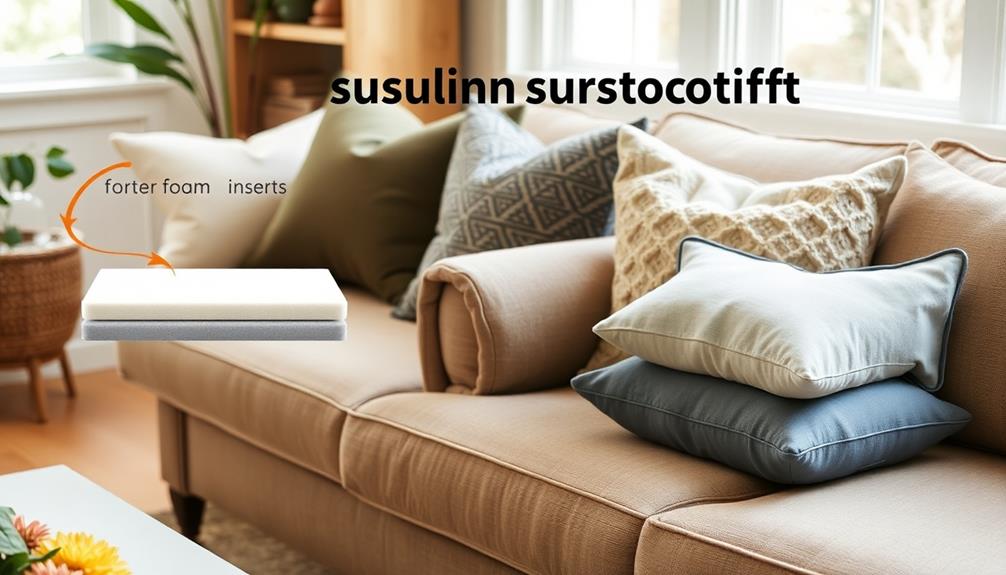
If you're tired of dealing with sagging sofa cushions, investing in cushion supports can be a game-changer. Rigid cushion supports provide the additional firmness you need, distributing weight evenly beneath your cushions to prevent further sagging.
They're compatible with various sofa styles, so you won't have to worry about extensive modifications. Implementing proper care and maintenance for your furniture, similar to how you'd for a pet like a hamster, can greatly enhance its longevity and comfort, just like ultimate hamster care guides suggest for creating a nurturing environment.
Using these supports can instantly restore the shape of your sagging cushions, boosting both comfort and aesthetics. You'll notice a difference in how your couch looks and feels right away.
Plus, regular use of cushion supports considerably reduces the likelihood of future sagging, helping to extend the lifespan of your sofa.
For those who prefer a customized seating experience, consider adjustable cushion support options. These allow you to tailor the level of firmness based on your comfort preferences, ensuring a cozy spot for everyone.
Don't forget to invest in quality couch cushion covers as well, as they can further enhance the look and protection of your cushions.
Cleaning and Care Guidelines
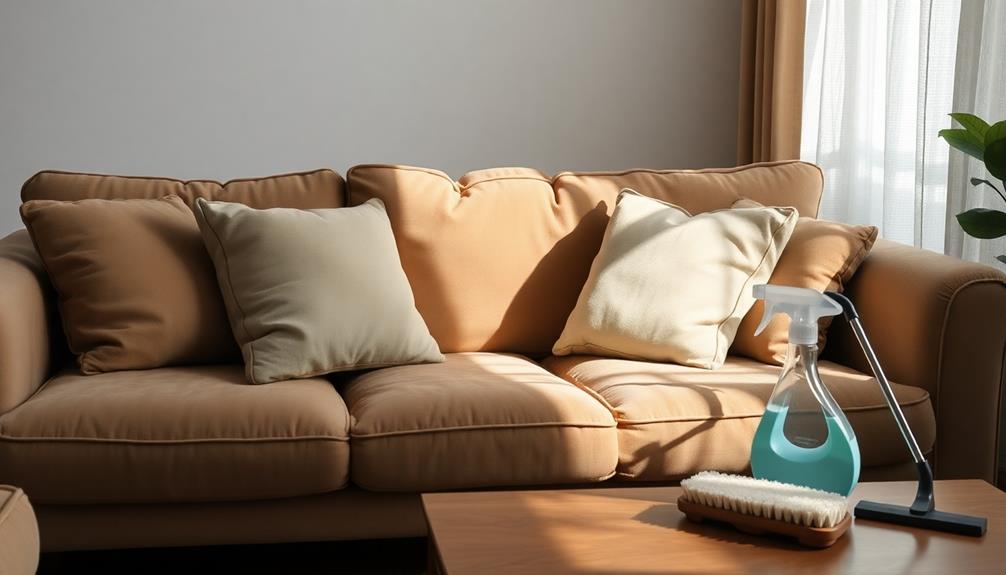
To keep your sofa cushions looking fresh, establish a regular cleaning schedule that includes both machine washing removable covers and vacuuming non-removable areas.
Incorporating gentle stretching before bedtime can also help create a more comfortable seating experience by alleviating tension in your back.
Don't forget to use spot cleaning techniques for any stains, and always check care labels to avoid damaging the fabric.
Regular Cleaning Schedule
Maintaining a regular cleaning schedule for your sofa cushions is essential for prolonging their life and keeping them looking fresh.
By following a consistent routine, you can prevent dirt and allergens from building up, which can affect the integrity of your couch.
Here are three key steps to incorporate into your cleaning schedule:
- Weekly Vacuuming: Make it a habit to vacuum your cushions weekly. This will help remove dirt and allergens, keeping your couch clean and maintaining a healthy environment.
- Wash Removable Cushion Covers: If your cushions have removable covers, wash them every few months on a gentle cycle. Always air dry them to maintain fabric quality and prevent shrinkage.
- Inspect and Clean Under Cushions: Periodically lift your cushions to check for hidden debris like crumbs or pet hair. Cleaning this area regularly will help prevent odors and wear over time.
Spot Cleaning Techniques
Spot cleaning your sofa cushions is vital for tackling stains and maintaining their appearance between deep cleans. To effectively spot clean, use a clean cloth dampened with a mixture of mild detergent and water. Gently blot the stained area without rubbing, as this can spread the stain further.
For non-removable cushion covers, consider using a steam cleaner on the upholstery to lift dirt and refresh the fabric. Just be certain to follow care labels to avoid any damage.
If you encounter stubborn stains on non-removable areas, rubbing alcohol can be a powerful agent. Apply it sparingly, and always test it on an inconspicuous area first to confirm it won't harm the fabric.
Regular vacuuming of your cushions, including the crevices, helps remove dirt and allergens, preventing buildup that may lead to more challenging stains later on.
After spot cleaning, it's imperative to air dry any damp areas thoroughly. This step helps avoid moisture buildup, which could lead to mold or mildew formation.
Keeping your sofa cushions clean and fresh will enhance their longevity and keep your living space looking its best.
Cushion Cover Maintenance
Keeping your cushion covers in top condition is essential for both appearance and longevity. Regular maintenance not only enhances the look of your sofa but also extends the life of your cushions. Here are some cleaning and care guidelines to follow:
- Vacuum Weekly: Make it a habit to vacuum your cushion covers weekly to remove dust, debris, and allergens. This keeps your living space clean and helps maintain the fabric's integrity.
- Wash Removable Covers: If your back cushions have removable covers, machine wash them according to the care labels. Use a gentle cycle and air-dry to prevent shrinkage and preserve the fabric.
- Spot Clean Immediately: For any stains, spot clean right away using a damp cloth and mild detergent. This prevents permanent marks and discoloration, ensuring your cushions stay looking fresh.
If your covers are non-removable, use a carpet cleaner with a handheld hose to tackle stains, following the manufacturer's guidelines.
Frequently Asked Questions
Can Couch Cushions Be Fixed?
Yes, you can fix couch cushions! Adding stuffing, flipping them regularly, or replacing foam inserts all help restore their shape and firmness. Regular maintenance like vacuuming also keeps them looking great for longer.
How Do You Fix a Couch That Is Sinking?
Fixing a sinking couch feels like trying to lift a heavy weight; it's frustrating. Start by adding high-density foam inserts, rotating cushions regularly, and using rigid supports for lasting comfort and stability in your living space.
How to Make Sofa Cushions More Firm?
To make your sofa cushions firmer, try adding high-density foam inserts or flipping them regularly. You can also use polyester fiberfill stuffing for restoration and rigid support panels to evenly distribute weight and prevent sagging.
How Do You Fill Saggy Couch Cushions?
When you're dealing with saggy couch cushions, unzip the covers and pack them with polyester fiberfill. Make sure you fill those corners well, restoring their shape. Regularly fluff them to keep everything nice and firm!
Conclusion
In the world of furniture, your sofa cushions are the clouds that bring comfort to your living space. By identifying common issues, addressing sagging, and applying effective repair techniques, you can breathe new life into them. Remember to maintain and care for your cushions, ensuring they stay plush and supportive for years to come. With a little effort, your cushions will feel as good as new, inviting you to sink into their embrace every time you sit down.
